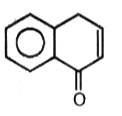 A
A
A is:
1. 3-keto butanol
2. Butan-1,4-dial
3. 1-aldo-2-butanone
4. 2-keto butan-1,4-dial
 A
A
A क्या है ?
1. 3-कीटो ब्यूटेनॉल
2. ब्यूटेन-1,4-डायल
3. 1-एल्डो-2-ब्यूटेनोन
4. 2-कीटो ब्यूटेन-1,4-डायल
 A
A A is:
 A
A A क्या है ?
Rank the following reactions A,B and C in order of increasing rate,
(A)
(B)
(C)
1. B>A>C
2. B>C>A
3. A>B>C
4. A>C>B
बढ़ती हुई दर के क्रम में निम्नलिखित अभिक्रियाओं A,B और C को क्रमबद्ध कीजिए,
(A)
(B)
(C)
1. B>A>C
2. B>C>A
3. A>B>C
4. A>C>B
Consider the following sequence of reactions.
 AB. The final product (B) is:
AB. The final product (B) is:
1. 
2. 
3. 
4. 
अभिक्रियाओं के निम्नलिखित अनुक्रम पर विचार कीजिए।
 AB, अंतिम उत्पाद (B) है:
AB, अंतिम उत्पाद (B) है:
1. 
2. 
3. 
4. 
Major product of the following reaction is:

1. butene-1
2. butene-2
3. butane
4. butyne-1
निम्नलिखित अभिक्रिया का मुख्य उत्पाद है:

1. ब्यूटीन-1
2. ब्यूटीन-2
3. ब्यूटेन
4. ब्यूटाइन-1
Which of the following alkyne on treatment with H2(2 mole)/ Pt gives an optically inactive compound ?
1. 3-Methyl-1-pentyne
2. 4-Methyl-1-hexyne
3. 3-Methyl-1-heptyne
4. None of the above
निम्नलिखित में से कौन सा एल्काइन H2 (2 मोल)/Pt के साथ उपचार पर प्रकाशिक निष्क्रिय यौगिक देता है?
1. 3-मेथिल-1-पेंटाइन
2. 4-मेथिल-1-हेक्साइन
3. 3-मेथिल-1-हेप्टाइन
4. उपरोक्त में से कोई नहीं
Most probable mechanism for this reaction is-
1. E 1
2. E 2
3.
4. elimination
इस अभिक्रिया के लिए सबसे संभावित क्रियाविधि है-
1. E1
2. E2
3.
4. विलोपन
Nitrobenzene on reaction with conc. HNO3/H2SO4 at 80-100°C forms which one of the
following products?
1. 1,2-dinitrobenzene
2. 1,3-dinitrobenzene
3. 1,4-dinitrobenzene
4. 1,2,4-trinitrobenzene
80-100°C पर नाइट्रोबेंजीन सांद्र HNO3/H2SO4 के साथ अभिक्रिया पर निम्नलिखित में से कौन सा उत्पाद निर्मित करती है?
1. 1,2-डाइनाइट्रोबेंजीन
2. 1,3-डाइनाइट्रोबेंजीन
3. 1,4-डाइनाइट्रोबेंजीन
4. 1,2,4-ट्राईनाइट्रोबेंजीन
Which of the following has maximum melting point ?
1.
2.
3.
4.
निम्नलिखित में से किसमें अधिकतम गलनांक होता है-
1.
2.
3.
4.
What products are formed when the following compound is treated with Br2 in the
presence of FeBr3?
1.
2.
3.
4.
निम्नलिखित यौगिक को FeBr3 की उपस्थिति में Br2 के साथ उपचारित करने पर कौन से उत्पाद निर्मित होते हैं?
(a)
(b)
(c)
(d)
Which of the following, when undergoing addition of HBr, will form ONLY a pair of diastereomers?
निम्नलिखित में से कौन, HBr के संकलन से गुजरने के दौरान केवल अप्रतिबिंबी समावयव का एक युग्म निर्मित करेगा?
















